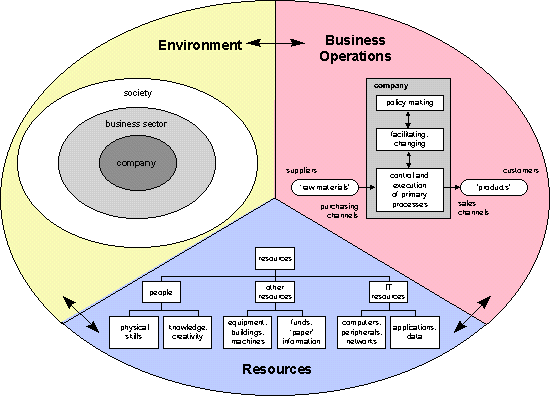
Vision
2. Business Transformations |
2.1 Introduction
The focus of this chapter is on business transformations. We provide a picture of changes that are currently taking place in companies as a result of social developments and developments in the various business sectors. We also describe how companies can deliberately implement changes in their organisation whilst making optimal use of the possibilities provided by information technology (IT). We call a deliberate change a transformation.

Figure 2.1 Subjects of change in companies. Changes and transformations involve a number of aspects:
The environment
A company derives the main motives for starting transformations from developments in its environment. Social developments on economic, social and cultural levels affect all companies and at regular intervals give cause for adaptation. Other reasons for transformation are specific branch or sector developments. Within their sectors, companies are confronted with changes regarding customers, suppliers, competitors and business partners. The people operating a company could consider the developments in their environment as threats they must respond to, but also as opportunities they can make the most of. Business operation
A company responds to developments in its environment by adapting its internal and external business operations. This refers to the way in which the company controls and executes its business processes and the way in which it deals with its customers and suppliers. Changes in business operation involve:
- the scope of the company, meaning the products or services the company sells;
- the external network of the company, consisting of the outlets and the type of customers the company aims for, the channels used for purchasing and the suppliers from whom the company purchases raw materials, energy and services;
- the way of controlling and executing the business processes.
The resources
A company realises changes in its business operations by adapting its configuration of people and other resources that together control and execute the business processes. Together, the business operation and the configuration of people and resources form the organisation of the company. With their knowledge, skills and experience, people form the heart of the organisation. Their vision and creativity are the main contributions to the business operation.
With respect to resources, we distinguish between IT resources and other resources. Other resources consist of material resources, such as buildings and machines, and of immaterial resources, such as financial resources and business data recorded on paper. IT resources consist of hardware, such as computers, networks, workstations and printers, and also of immaterial resources, such as software and data that are electronically stored. People and resources form the ‘working capital’ of the company.The role in transformations of IT
As a result of the increasing use of IT, the IT resources form an increasingly large part of the configuration of the company. IT mainly facilitates data storage and data processing, communication between people and process control. IT is a tool for implementing transformations. With IT, companies can improve and renew their business operations. This way, IT enables companies to respond to developments in their environment, to introduce new products and services, to enhance the sales potential, to improve customer services, to improve their co-operation with other companies and to maintain or even increase the level of turnover and profit.The approach to change
The growing possibilities for applying IT force companies to devote specific attention to IT in their approach to the change processes. There is an increasing need to plan and realise the changes in business operation, human organisation and the application of IT as a whole in transformations.
More and more changes in business operation are only possible with the use of IT. Still, in transformations IT remains just one of the resources. The other resources, and especially the people, deserve attention, for new IT often has far-reaching consequences. On the one hand, transformation by means of IT for example leads to a demand for people with different knowledge and skills, both with respect to business operations and to the management and maintenance of the new IT. On the other hand, the need for people with available but obsolete knowledge disappears. A sound strategy will therefore aim for the timely development of new knowledge and skills through re-education of available employees and through the timely development of knowledge and experience with the new IT.In the following sections we describe the various aspects of business transformation by means of IT in more detail. Section 2.2 discusses social trends that may lead to business transformations. In section 2.3, we provide an overview of the changes that are currently taking place in a number of important business sectors. We also discuss the role IT plays in this matter. In section 2.4, we discuss a number of trends with respect to changes in the internal organisation of companies. Sections 2.5, 2.6 and 2.7 give some advice on how companies might handle transformation of their organisation in combination with an increasing use of IT. Section 2.8, finally, contains a conclusion.